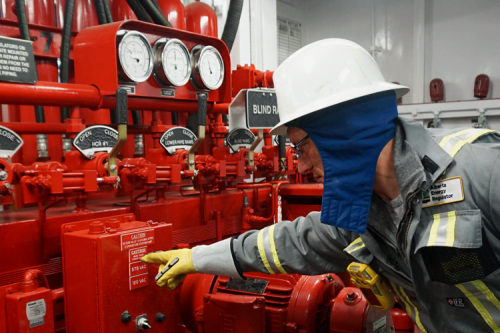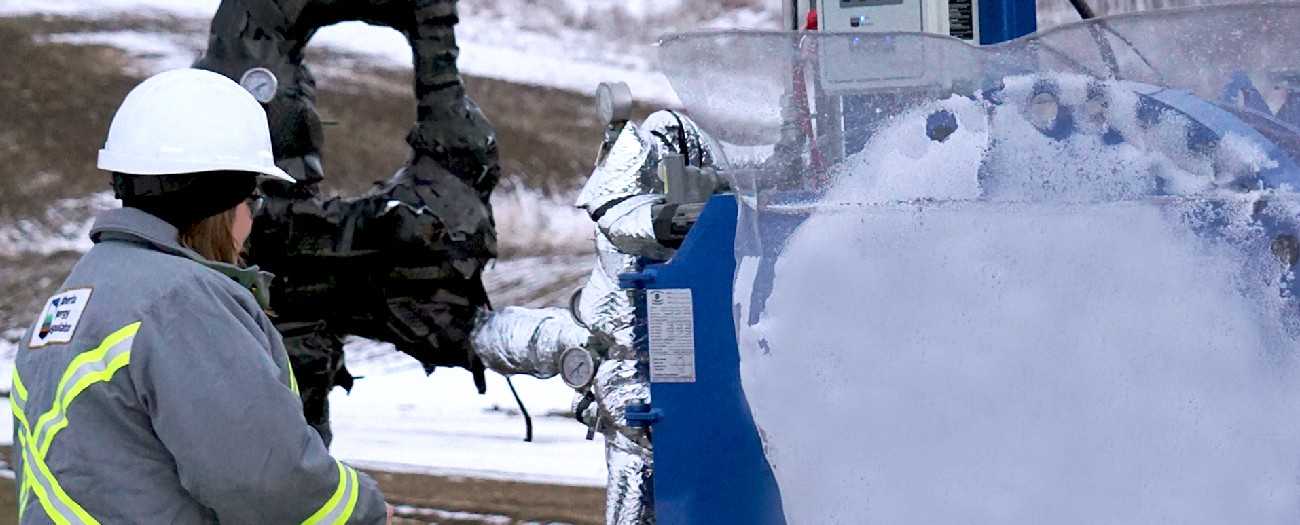For the uninitiated, visiting a drilling rig is a learning experience
Alberta - February 28, 2017I’m from corporate. I work in the shiny head office in the shiny city of Calgary.
But for three days, I traded in the business attire for the grey coveralls worn by the Alberta Energy Regulator’s (AER’s) inspectors; instead of slipping my feet into my pointy-toed heels, I laced up my steel-toed boots and slapped a hard hat on my head to go out into the field with Sean Humphreys and Barry Smith from the AER’s Bonnyville Field Centre.
Those days in the field were incredible and I loved every minute of each day. Aside from cherishing the spacious coveralls—which are beyond comfortable—I toured an actual working drilling operation.
Chance of a Lifetime

Barry Smith inspects the accumulator.
Admittedly, at the end of each day, my brain felt swollen from all the information I had ingested. Humphreys and Smith, both former rig workers, made it their top priority to show and tell me as much about drilling as they could. Smith, a self-proclaimed “statistic of the patch” and the son of a drilling superintendent, has spent his entire life on or around drilling rigs. He arranged to get us on a walking rig. Before that, I’d only seen rigs and derricks in photos. For a neophyte like me it was the opportunity of a lifetime.
The crew on this particular rig rolled out the red carpet—Smith’s charm is quite powerful—giving us a tour that made us feel like high-ranking officials from a visiting delegation. Stepping out of the truck and looking up at this impressive machine ignited all of my senses—the loud hissing and powerful vibrations coming from the rig, the damp heat that hit my face as I entered the rig’s belly, and the smell of the drilling mud being pumped up from the earth were nothing like I had experienced before.
One of the more interesting aspects of the tour was seeing what AER inspectors inspect on a drilling rig—the blowout preventer (BOP) and the accumulator, which is the equipment that operates the BOP. On this rig, the accumulator was hard to miss: a large red machine. These devices ensure that the rig operates safely, and inspecting them requires a battery of tests and pouring over documentation.
“When we’re inspecting, we’re there to ensure that the people are safe and that the environment and the resource are protected,” says Smith. “One of our main focuses is on blowout prevention, which means thoroughly looking at the operator’s paperwork and testing and retesting the equipment.”
Learning the Lingo
While I learned a lot about drilling operations, I also picked up some new lingo. So for those looking for a crash course in oilfield jargon, here are some notable terms:
Dog house: Not the place one is banished to when things go amiss with your partner, the dog house on a drilling rig is much like the cockpit of a plane; it’s where all of the rig’s controls and monitoring equipment are and where its operator sits.
Fish/fishing: No, you don’t want the “big one” here. Fish refer to equipment or debris that fall into a well; fishing is the act of retrieving that debris.
Kill: Although quite ominous, the term to “kill” a well simply means to stop the flow.
Kick: When a formation fluid such as gas, oil, or water unexpectedly enters the wellbore and interrupts the drilling process. A kick could be a sign that a blowout is coming.
Mud: Once you see drilling fluid up close, it’s easy to understand why it’s commonly referred to as “mud.” Drilling fluid, or mud, looks and smells like mud and is used to keep the drilling bit cool and clean, prevent formation fluids from entering the well, flush out drill cuttings, and suspend the drill cuttings while drilling has paused.
Rig mat: A protective barrier or platform between the ground and the rig. Rig matting can also be used as a temporary road to protect the ground from traffic during drilling operations.
Shacks: The living quarters for the crew during drilling operations until their rotation is over or the drilling is completed. They are very similar to the trailers you would see on a construction site.
Toolpush: No, this isn’t someone who walks around pushing workers to use specific tools. A toolpush, or rig manager, actually has a lot of responsibility on site because he or she is in charge of the drilling rig’s operations and the crew.
V-door: A ramp running from the floor of the derrick to the ground used to move equipment and tools on and off the rig.
Walking rig: A true innovation in oilfield technology, walking rigs, through the power of hydraulics, can “walk” from one well to next. It’s not a fast process, but it’s quicker, more efficient, and safer than dismantling the rig, and hauling the pieces to be reassembled at the next well to be drilled.
Although far from being a seasoned expert, after learning about the operation and feeling, smelling, hearing, and seeing it in action, I have a new perspective on this activity. And when I hear these terms spoken now, I no longer worry when one of our inspectors is sent to the dog house.
Cassie Naas, Writer


